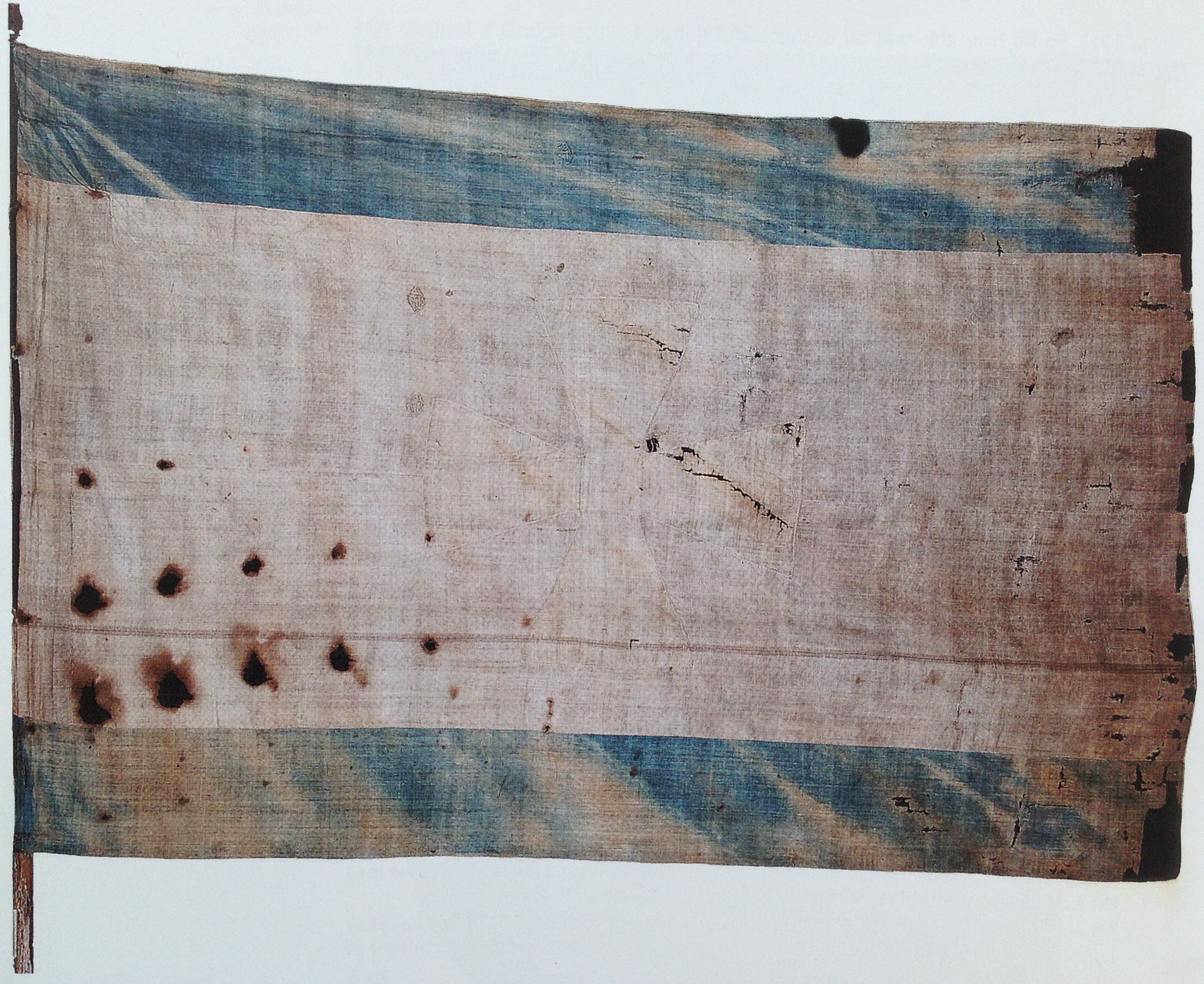1651.
Canvas.
Needlework; painting.
Height: 140 cm, Width: 210 cm, Flagstaff: 244 cm.
National Swedish Museums of Military History. Army Museum (Armemuseum), Swedish State Trophies Collection.
One of the most unique and priceless artifacts surviving today, this Cossack flag is from the period of the National Liberation War of the Ukrainian people, which took place in the middle of the 17th century. The flag's colors have faded with time. There are marks left by firearms in the lower right corner, an indication that the flag was carried in battle. Various watercolor paintings from the 17th and 18th centuries help us restore the flag's original appearance: it was a light cherry color. The cross located in the center of the flag, which is barely visible now, was white. The top and the bottom parts of the banner are decorated with azure edging.
The flag was lost on June 26, 1651, at Ripky. Cossack troops led by Chernihiv colonel Martyn Nebaba were defending Kyiv against the attack launched by the army of the Lithuanian hetman Janusz Radziwill. awings and descriptions of the Cossack flags taken during the Kyiv and Ripky battles were provided by a witness to those events. Today they are kept among the papers at the Janusz Radziwill Department of Manuscripts of the Saltykov-Shchedrin Russian National Library in St. Petersburg. A total of 26 flags are depicted in the drawings. Twelve of those flags were kept in Stockholm (as evidenced by the watercolors by Goffman). Another 10 flags survived until today and belonq to the State Trophy Collection of Sweden.
Military flags obtained in battles were considered very valuable trophies and were traditionally presented as gifts to the royalty to express devotion and loyalty. Evidently, Janusz Radziwill followed this custom, reporting with great pride on the military campaign of 1651 to the Polish parliament. This event had a significant political subtext: the field hetman wanted to exalt the Polish king in the eyes of the parliament as the main leader of Rzeczpospolita's military success and to quell suspicions about his own claims to the hetman bulava (mace) that were ascribed to him by his many adversaries. Together with his cousin Boguslaw Radziwill, who also carried out a successful campaign in 1651 and was stationed at Berestechko with his three regiments as part of the royal army, the Lithuanian hetman presented the king with 36 flags taken from Cossacks and Tatars. Here is how researcher Ya. Smirnov described these events, citing sources in his fundamental work«Drawings of Kyiv in 1651 based on copies from the end of the XVIII century»: «The next year, 1652, began with a triumph for Count Janusz at the Sejm [parliament] in Warsaw; after arriving at the Sejm a month after its opening, on February 26, in the absence of the crown hetman, Janusz delivered a report on the success of both armies all the way through to the Bila Tserkva agreement. Expressions of gratitude lasted several hours. This report by Count Janusz about the war of 1651, as well as that of 1649, was evidently similar to the 'Commentary' (an essay by an anonymous author, published in 1653 and 1655 and dedicated to the Cossack revolution as reflected in its title, 'Commentary on Lithuanian affairs during the Russian rebellion'; the first publication appeared in Kenigsberg, the second one in Elblong), at least in regard to content, if not in the text itself. The king was presented with 36 flags and badges taken from the Cossacks and Tatars by Janusz and Boguslaw Radziwill and the General of the Senate thanked them personally while expressing his gratitude to all those fighting for their homelands The significance of this event was noted in the foreign press. In particular, the «Gazette de France» relayed this episode to its readers in a report from Warsaw on March 14,1652.

It was established that this flag was obtained «secondhand»: it was captured by Swedish troops during the famous three-day battle for Warsaw in 1656. From that moment, the flag's fate was linked to one of the world's biggest and richest flag collections, which be- came known as the Swedish State Trophy Collection in the 20th century.
The earliest inventory, from 1685, attests to the fact that the flag was located in Sweden in the second half of the 17th century. Between that time and the start of the 19th century, flags were kept in various castles and palaces of the northern kingdom. In particular, beginning in 1691, they were likely stored in the De la Gardie Palace called Makalos (Matchless), then from 1783 in the Fredrikshof castle and then from 1803 to 1817 in the Orangery in Stockholm. In 1817 they were ceremoniously transferred to Riddarholmskyrkan (the Riddarholmen Church), the mausoleum of Charles XII, where they were kept until the beginning of the 20th century. The Northern Museum (Nordiska museet) became the next place to house the flags. Since 1960, the trophy collection has been located at the Army Museum (Armemuseum), founded in 1879 as an artillery museum (until 1932 it was called the Artillerimuseum).The Swedish State Trophy Collection is one of the largest collections in the world, containing flags from different historical periods and from many European nations. It accumulated military victory trophies of Gustavus II Adolphus, Charles X Gustavus, Charles XI, Charles XII and their successors. The Cossack flag shown here was restored in 1946.
Kyiv & Ukraine Private Tour Guides
|